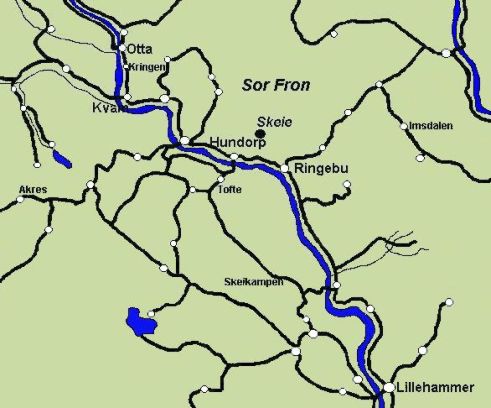
The Scheie family
NOTE
Most of the following account of the Scheie family is based on the research of others: Sunniva
Scheie Aaseng wrote a remembrance of her childhood. Johanna Scheie wrote about her
grandparents. Agnes Scheie kept a record of vital family facts: dates of births, marriages, deaths
and jobs.
Paul Scheie visited the area in Norway where our Scheie and Fosmark ancestors came from and
wrote a booklet about them in 1988. I have borrowed generously from that booklet and perhaps
even more from a voluminous e-mail correspondence with Paul in recent years.
David L. Scheie
July, 2005

The Scheie history
The earliest known members of the family came from Gudbrandsdalen (Gudbrands Valley) in the
Norwegian fylke or county of Oppland. The area lies along the Lagen River and rises gradually
toward the mountains to the north and east. It is about 120 miles north of Oslo.
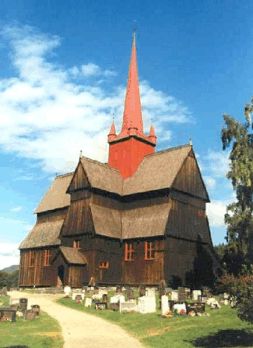
Until 2003, our earliest known Scheie ancestors were Mari Pedersdatter,
born 1747, and her husband Ole Torgersen, born 1754. Although the
records of our branch of the family, the descendants of Iver Olsen Scheie,
contained only the years of their births, those of the Lodver Olsen Scheie
(Louis Schye) family indicated that Ole Torgersen was born on August 10
of that year. Both records showed that he was born in Larsok, a place
we could not find on any map.
But we discovered that Larsok was not a place but a date and that date
was August 10 which was St. Lars’s (or St. Lawrence’s) Day, the day
of his death.
We learned that the occasion was observed at the historic Ringebu
Stavkirke or stave church. It is one of two such churches in Norway
dedicated to St. Lars.
Then Paul Scheie found a record of an Ole Torgersen baptized at the Ringebu
church September 15, 1754. His parents were Torger Pedersen Holt
and Anne Povelsdatter.
He could not find a nearby site called Holt but did find a Torger Pedersen baptized at Ringebu July 3, 1713.
Torger’s parents were Peder Torgiersen and Goro Ingebretsdatter.
To understand Norwegian genealogy, one must understand the Norway’s patronymic naming
system which was followed until the twentieth century.
An oldest son’s first name was usually that of his paternal grandfather. An oldest daughter’s
first name was that of her paternal grandmother. A second son was named after his maternal
grandfather and a second daughter after her maternal grandmother. The rules are less strict for
later children, but family names are often used.
A child’s second name would specify his or her father. Thus, Ole Torgersen was the son of
Torger; Mari Pedersdatter was the daughter of Peder.
The third name would indicate an address. Torger Pedersen Holt was the son of Peder and lived
at Holt. If the family moved, that third name would change.
(For a more complete discussion of this issue, see Norwegian naming practices.
As for the suffixes to male names, Norwegian records almost always use “sen” to mean son.
When they came to American, most Norwegians used “son.”)
So, as of now, we believe our earliest Scheie ancestors were Peder Torgiersen and Goro
Ingebretsdatter, born sometime late in the 17th century.
They were the parents of Torger Pedersen Holt, probably born in 1713. Torger married Anne
Povelsdatter and they had a son, Ole Torgersen, born August 10, 1754.
Until 2007, family records agreed that Ole Torgersen and Mari Pedersdatter became parents of son
Ole and that he was born on March 27, 1791. But then it was noted that his gravestone, near
St. Peter, Minnesota, showed his birth date as September 29, 1791. We feel that the latter date,
almost surely specified by his widow and daughter, is more likely correct.
We may also wonder why was he known as Ole Lodversen rather than Ole Olsen when his
father’s name was Ole? Why did he change his name? Where did the “Lodver” come from?
We may never know for sure, but we have some hints.
The 1801 Norwegian census shows a Lodver Olsen, born in 1766, and his wife, Anne
Davidsdatter, living on the Steig farm near Hundorp west of Ringebu and north of the Lagen
River in an area known as Froen or, later, as Sor-Fron. Among their family was a ten year old
son Ole (therefore born probably in 1791) and three younger children: Iver, 4; Joen,2; and Kari, 8
That same census shows an Ole Torgersen was a hired hand on another farm in South Fron and
Mari Pedersdatter was a servant on that farm. They are not shown to have any children living
with them.
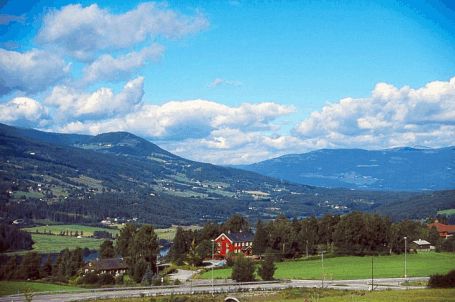 The Lagen valley near Hundorp
The Lagen valley near Hundorp
It is possible that Ole and Mari were for some reason unable to raise their son, that he went to live
with Lodver and Anne, and took his name from the latter couple, becoming Ole Lodversen.
We are aware of at least two other instances in which a son changed his patronymic name from
one designating his birth father to another naming the man who raised him.
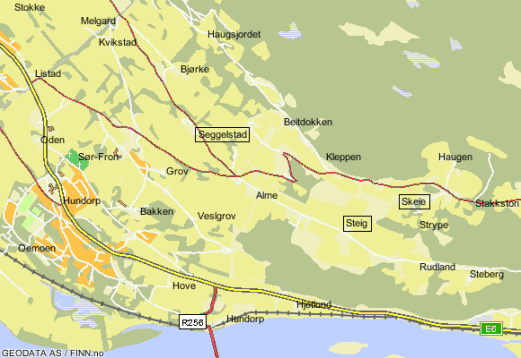
The Steig farm, east-northeast of Hundorp, was a large estate which dates back at least to the
time of St. Olav (995-1030) in the Viking era and perhaps as early as 800. The Skeie farm was a
subdivision of the Steig estate and it lies near the top of a low mountain or large hill
Norway has at least 18 places named Skeie and the 1865 census shows 522 people living at those
farms, most of them in Rogaland, near Stavanger. Oppland has the least.
Province Number
Rogaland 237
Hordaland 169
Vest-Agder 88
Telemark 39
Oppland 19
The name Skeie is believed to be based on the Old Norse word "skeid" which means a strip of
land suitable for horse racing, often located near ancient pagan worship grounds. Some scholars
suggest that the horses may have been raced on and around fields during spring fertility rites each
year. In later times, it meant a road or track between fields and not necessarily used for racing.
The name was spelled several ways: Skeie, Schjeie, Skjeie, Scheie and there were probably other
variations. All are pronounced the same: preferably SHEH-ee-eh or sometimes SHAY-a.
The Skeie farm we are concerned with is sub-divided into Norskeie (North Skeie) and Sorskeie
(South Skeie). The buildings are only a few hundred yards apart.
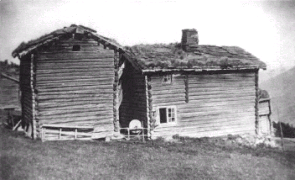 Sor Skeie
Sor Skeie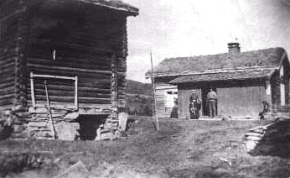 Nor Skeie
Nor Skeie
Ole Lodversen and his family lived on Sor Skeie and, according to one account, his parents on
Nor Skeie. Iver's smallpox vaccination certificate in 1849 gives his name/address as Sorskjeie. A
reported church record of Mari's wedding gives her address as Steigskeie.
Ole Lodversen, was recorded in the Norwegian census of 1865 as a husmann med jord, that is, a
cotter or one who was given the use of a house and some land usually on the edge of a large farm
owned by a bonde or selveier.
In 1723, the estate had three farmers; in 1801 it had nine and in 1865, about the time our
ancestors left for America, there were twelve. In that last year, the two Skeie farms also had one
horse, fourteen cattle and 26 sheep.
The increase in those numbers may have been made possible by clearing trees from the land. It
also reflects the population growth and related land shortage in rural Norway that prompted so
many to leave.
During the 19th century, the number of husmenn grew so that many of them could not find good
land. This became a major inducement to emigration.
For more on types and names of Norwegian farms and farmers,
see Norwegian naming practices.
One June 3, 1829, Ole Lodversen married Anne Halvorsdatter whose name is sometimes given as
Anne Halvorsdatter Segelstad (or Sejelstad or Seggelstad) which indicates she came from a farm
or that name about two miles west of the Skeie farm (see map, p. 4); the 1865 census shows her
coming from Ringebu parish. Anne was born on March 7, 1807.
Ole and Anne had eight children:
Birth date Christened
Mari Olsdatter June 27, 1830 August 1, 1830
Anna Olsdatter February 2, 1833 March 3, 1833
Marit Olsdatter October 5, 1835 October 11, 1835
Ole Olsen September 8, 1838 October 14, 1838
Lodver Olsen September 27, 1841 October 3, 1841
Hans Olsen September 20, 1844 September 29, 1844
Iver Olsen December 31, 1847 January 16, 1848
Anne (or Ahne) Olsdatter April 18, 1851 May 4, 1851
My grandfather Iver was confirmed in the Sor Froen church on June 22, 1862.
Little is known of their life on the farm, but Iver is quoted by daughter Sunniva as saying his
childhood was a dreary time. Grant Olson indirectly quotes his grandmother Mari Olsdatter
Holen as saying the family was very devout.
From Norway to America
The family's emigration to the United States began in April, 1856, when Mari, the oldest, left with
her husband Ole Paulsen Holen. They had married June 1, 1852, and had a daughter in 1853..
Family records show her name was Anna; the 1860 census shows it as Rønnøg. When they
arrived in America in 1856, Ole was 34, Mari was 22 and Anna (or Rønnog) was
3½. They settled near Westby in Vernon (then Bad Axe) County, Wisconsin.
A year later, in 1857, Anna Olsdatter, the second oldest child, her husband Ole Hansen Skeie and
their two year old son left along with her younger sister Marit Olsdatter. We have no more
information about them.
The bygdebok, a Norwegian historical record of an area, says Marit was
Ole's sister, but Paul believes that is an error. Ole was apparently from
another of the families living at the Skeie farm.
The family's emigration was suspended after 1857, then resumed following the American Civil
War. Before 1870, most Norwegians came to America by sailing ship. The cost was usually
between fifteen and thirty dollars. But steamers came into use during the 1850s, made safer and
quicker crossings and also provided food en route. Still, the cost was about three times that
charged by a sailing ship. During this time, many Norwegians sailed from Norway to Hull,
England, where they took a train to Liverpool, then boarded a steamer for the U. S.
After 1855, nearly all Norwegian immigrants disembarked in Quebec rather than New York.
There were several reasons for the change. One was the revocation of the British Navigation Act
in 1849 which made it easier for ships to carry cargo from Canada on the return trip to Europe.
Another was that Quebec authorities were not so particular about the number of passengers
carried on a ship.
Norwegian emigration to America virtually halted during the Civil War, then surged. The first of
the three largest waves of Norway-to-America emigration ran from 1866 to 1874.
Among the emigrants of 1866 were Ole Olsen Skeie, then 27, his wife, Anne Jakobsdatter, 25,
and their son Ole, born in 1864. We know nothing further about them.
 The bark “Chapman”
The bark “Chapman”
The following year, the parents--Ole Lodversen, then
75 years old, his wife Anne, 60--and their three youngest children--Hans, 23; Iver, 20 and Anne, 16–left for
America. They departed from Christiania (Oslo) on
July 3 on the sailing ship Chapman under a Captain
Bjonness or Bjorness and arrived in Quebec August 27.
Their 56-day voyage was slightly longer than the average
of 53 days.
On the Chapman’s passenger list, the family is recorded under the
name “Ole Lodversen Scheie.” That is one of the first times we have
seen that spelling used for what became the family name. It also
indicates they had chosen that to be their American name before they
left Norway.
All Norwegian immigrants had to decide between their patronymic and their place names when
they became Americans. Our family chose the place name; otherwise our name would be
Lodversen.
The spelling of our name might not have been entirely settled before the voyage, however. The
name on the trunk Iver used to hold his belongings on the trek to America was “I. O. Schjeie;”
Paul still has that trunk. Iver used that same spelling when applying for citizenship in 1869.
According to his citizenship application Iver, and presumably the entire family, entered the United
Stations on September 20,1867. What the family did during the twenty-three days between
arriving in Quebec August 27 and entering the United States, probably at Chicago, on September
20 we do not know.
Neither is it clear why they came, but it’s likely that they, like so many nineteenth century rural
Norwegians, felt the pressure of over-population and land shortage and saw greater opportunity
in the New World. Particularly since they were tenant farmers and not landowners, they would
have had limited prospects of a better economic life in Norway.
Nor do we know whether their immigration was a planned, step-by-step process or if glowing
reports from earlier immigrants, including their children, persuaded Ole, Anne and their remaining
children to follow.
Since Ole was 75 when he immigrated and did not apparently seek homestead land, it seems likely
that he and Anne came to America mainly because they felt it would be best for them all–and it
would at least afford the chance of their children being together..
We don’t know when Lodver Olsen emigrated, but it was sometime between May, 1867, and
July, 1870. Lodver had married Paulina Martina Christensen (born December 7, 1838) in Norway
in about 1866. According to the 1880 U. S. Census, their first child, Ole Anton, was born in
Norway on May 18, 1867, and their second, Anna Christiana, was born in America on July 5,
1870.
Lodver changed his name to Louis Schye on arriving in America. Virginia Schye said his descendants believe
immigration officials in Baltimore came up with the Schye spelling.
Louis and Paulina settled in the Chicago area where he worked as a shoemaker.
For an account of the Louis Schye descendants, see section at the end of the
Scheie history.
Settling in America
Once in the United States, the family members went separate ways. As we noted, Mari and
husband Ole Holen had settled near Westby, Wisconsin.
Marit married Iver Christensen Hovland, a native of Faaberg in Gudbrandsdalen, Norway, and
homesteaded near St. Peter, Minnesota.
We don't know what happened to Anna and her husband Ole
Hanson Skeie.
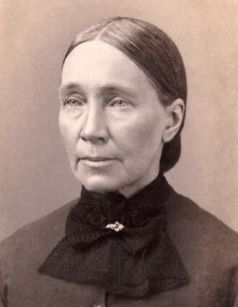 Marit Scheie Hovland
Marit Scheie Hovland
Hans is believe to have settled with Ole and Lodver in Chicago soon after
arriving in America and, like them, changed his name to Schye. Other than that we know nothing more about him although he reportedly remained a bachelor.
Ole Lodversen Scheie and his family eventually joined daughter Marit and husband Iver Hovland in Minnesota.. But since Ole was not listed among members of the Nicollet Norwegian Lutheran Church (since 1958 Norseland Lutheran Church) in 1868 (Iver Hovland is), it is quite possible they spent a year or more elsewhere, possibly with daughter Mari and Ole Holen near Westby, Wisconsin.
Contributing to this impression is a letter Iver sent to his parents in 1868 from LaCrosse, 25 miles northwest of Westby, where he and Anne had obtained work.
Dear Parents,
I must send you some news again, and I can tell that I have received
a letter from sister Marit and I. C. Hovland and they are all healthy and living as usual, and they
said they had increased their family with a son who was born in July and he is
healthy and active and is growing fast and further they say they had a good year
but they did not manage to say how large the harvest was. He explains that he has
bought 40 (acres?). The land has lain fallow and he thinks how he can pay for it
with the crop for this year? And they asked me what they should do with the
money from it if you don't need it immediately. So he really wishes to know
whether they can keep the money this winter? But in case you want it he will send
it immediately.
Concerning Ana and I, we are both healthy and are managing well. I earn on the
average $1½ per day and I hope it will continue this winter. I hope you send my
overcoat...
Ana now is at the same place and is managing well, and she has now received her
pay from the Fleishers where she was before she traveled up here.
From Hans and Lodver I have had no news for a month and then Hans was well
again...
I wrote a letter to you a while ago which I hope you have received. How long ago
I cannot remember but it was since Ana came here again.
Since the Holens are listed in the 1870 census at Westby and the Scheies are not, we suspect they
moved to the St. Peter, Minnesota, area about 1869. As we noted, Iver applied for U. S.
citizenship at Alexandria, Minnesota, in that year.
Clearly, they had moved by 1871 when Iver enrolled at Luther College, Decorah, Iowa, since he
then gave his address then as Mankato, Minnesota, which is close to St. Peter. That may have
been his parents’ mailing address--or perhaps they had moved a time or two within the area.
Iver as a young man
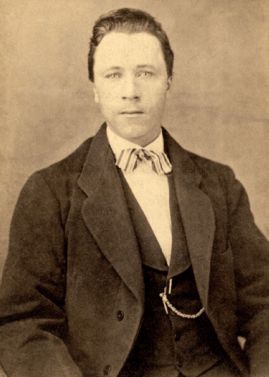 Iver Scheie
Iver Scheie
Iver Scheie, as he then spelled his name, remained a student at Luther
for three years, until 1874. Like most of his classmates, including those who
went on to the seminary, he did not earn a B. A. degree.
He may have left Luther for reasons of health or a struggle over his calling in life.
In an April 14, 1874, letter in Norwegian from St. Peter to a Prof. Larsen,
he writes:
I am happy to be able to inform you that I am
considerably better. I have in the meantime not
done any more studying. When I work at physical
labor I feel no pain in my head. I have not yet
been able to contact Pastor Borge (probably Rev.
Michael Borge who was married to Aagot
Fosmark and who lived in Mankato at least in
1882), from whom you suggested I should seek
counsel, although I have been to his place several
times.
I have during the last two or three weeks been working
with another man in carpenter work, and have felt fairly well in that
work, seeing it is out in the fresh air. In the meantime, I find that work quite tiring
since I have been away from it for some time.
But my interest is more in schooling and spiritual work. I hope then by God's grace
that your work and concern for me shall not be wasted. If I shall not be considered
worthy to continue and be of help to others, I hope that what I have learned at Luther
College shall be an eternal blessing for me. I am especially grateful to you for your
human blessings.
Sincerely, I. O. Scheie
In another letter to Prof. Larsen on July 26, 1874:
Since I am not well yet, I still cannot decide what I shall do. In the meantime, I
remember I have been just as poorly before vacations and I could not even stand to
read much until I returned to school. So I am thinking of trying it again.
I became quite well after having stayed at home for a time. But after the severe
heat has returned I have felt more poorly. I do not seem to get any worse from
reading, especially when I am not working. On Sundays I have lately read a
sermon and have not felt any worse. I had evidently worked too hard until I
received word from you in regard to that. Now I have discontinued that until
school begins again.
Iver makes no mention of it, but he was about to marry or maybe already had married Anette
Ulland. But two years later, in 1876, Anette died. Perhaps temporizing, Iver continued working
as a carpenter in Mankato.
But by September of 1878, he had made a decision and enrolled in Luther Seminary, then in
Madison, Wisconsin.
He graduated May 23, 1881, having "demonstrated a diligence combined with a Christian conduct
and now with the determining evaluation, the Pro Canditura Exam, on May 21st and 23rd, has
proved able to cover the holy preaching office in an Evangelical Lutheran congregation..." (From
"Testimony" signed by F. A. Schmidt and J. T. Ylvisaker).
Iver as a pastor
Following his ordination, Iver became pastor of congregations in Hudson and River Falls,
Wisconsin. In a letter from Hudson on October 4,1881, he wrote to Pastor H. A. Preus, then
Luther Seminary President:
In Kirketidende (a church paper) I have seen a notice to all who are indebted to
Student Support Treasury, and are unable to pay. I am indebted for expenses for
three years, besides $45.00 for traveling expenses. For the present I am unable to
pay. I must therefore according to your requirement give a note. This becomes a
bit difficult for me if it shall be interest bearing since I am indebted a great deal
otherwise and here there will be only enough for living expenses. I have now been
here five weeks and have received five dollars...
I thought however to ask if I could possibly get some salary from the Mission
Treasury. I am in debt a great deal at a store in Madison, and would like to be able
to pay some of that. I could perhaps get John Fosmark to arrange that for me...
(almost surely John Fosmark of Spring Prairie, the father of Marie whom Iver
would marry two years later. John was the brother of Aagot Fosmark Borge
mentioned above)
Otherwise, I find myself quite satisfied here. In Hudson, there are a good number
of congenial people. There is a good interest in church also, though they are few
to carry on the work. Not more than 15 or 16 families so far. And this is so far
the only congregation in River Falls, not yet really organized.
After nine months in Hudson, on July 6, 1882, Iver received a call from the Church Council for
The Norwegian Evangelical Lutheran Synod in America to become pastor of the Whitewater,
Heart Prairie and Skoponong congregations in Walworth County, Wisconsin, southeast of
Madison.
Papers included with the letter of call state that a year before, Whitewater and Heart Prairie had
decided to join with Skoponong in calling a pastor. Whitewater and Heart Prairie would each
would pay him $125 dollars per year, plus three holiday offerings and any payments for ministerial
services (weddings, baptisms and funerals). Heart Prairie and Skoponong, the rural
congregations, would provide him with free winter shelter, oats for a horse and some wood.
Skoponong would pay a salary of $150, plus offerings and "accidentals."
He accepted.
In addition to ministering to his congregations, Iver courted Marie Fosmark, formerly of
Spring Prairie, some 50 miles away. They were married a year later, on September 19, 1883, by
Rev. H. K. Preus in Fergus Falls, Minnesota, where her parents had moved in 1881.
Iver was 35; Marie was 21.
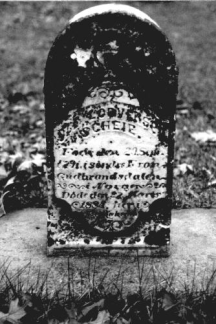
Early in the next year, Iver's father, Ole Lodversen Scheie,
died--on March 22, 1884. His death was attributed to
appendicitis that was said to have been medically mis-managed.
He is buried in the cemetery of the Norseland Lutheran Church
(Evangelical Lutheran Synod) eleven miles west of St. Peter,
Minnesota. His grave is marked by a simple stone giving his
name, date of birth and date of death in Norwegian.
Next to his is the grave of a Hovland, perhaps Ole's daughter
Marit or a member of her family.
We visited the site November 27, 1987.
Life in Whitewater
Later in 1884, Iver and Marie had the first of their nine children, all born in Whitewater:
Sunniva Antonetta November 7, 1884
Amanda November 18, 1886
Martha Johanna August 10, 1888
Olga Anetta October 29, 1890
Jennie Henrietta December 7, 1892
Agnes Caroline April 14, 1895
Olaf Johan July 29, 1897
Lodver Fosmark August 30, 1899
Ingeborg Marie July 8, 1901
In a wonderful reminiscence of her childhood, Sunniva says the Whitewater parsonage had been
home to several pastors and some of them had added to it here and there. She said only one part
had a second story and as a whole it was not very convenient. Heat was provided by hard coal.
Light came from hanging kerosene lamps. One light, in the kitchen, had an adjustable reflector
which could throw more light where needed. Iver used to sit by it and read on winter evenings
while Sunniva did homework.
Under the house was a cellar with stone walls and a dirt floor
packed so hard it could be swept with a broom.
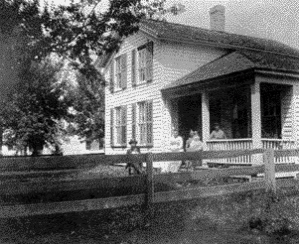 The parsonage in Whitewater
The parsonage in Whitewater
The parsonage had a large yard with a
boardwalk running along the street and up to
the house. Another walk led to a lot line
where there was an open well they shared
with a neighbor. Water was obtained with
rope, pulley and bucket. Soft rainwater was
kept in a cistern close to the kitchen.
One side of the yard had a garden which was
later abandoned, possibly due to constant
invasion by the neighbor's chickens. The one-time
garden was planted in grass and became a
croquet court. Iver loved croquet.
A barn, in which a horse was kept, stood on the back of the lot.
Breakfast included oatmeal every day; sometimes buckwheat cakes were included until Iver found
they left him with indigestion. After breakfast, Iver read from the Bible and the family often sang
a hymn--in parts. Sunniva thought her father had near perfect pitch.
She described him as very considerate, but noted that he expected immediate obedience...
or he could administer some hard strokes, and we sometimes thought unjustly.
What he said would sometimes hurt as much as a slap. I remember one Saturday I
didn't have my Bible history well prepared and after class I went into a corner and
wept, because of his scolding.
He did try Mother's patience at times. When there was some job around the house
she wanted done he would stall until some day when he felt like doing it, whether
it was convenient for her or not. But he was very handy about fixing up things.
He said that Mother was blessed with great patience.
The children started learning the catechism as soon as they were old enough to memorize.
Sunniva wrote:
Father was my best teacher. I remember more of what he taught me than any
other teacher I've had. One winter he wasn't so well so didn't go out much, then
he taught me arithmetic, reading, spelling and geography...So when I started
school I was almost 9 years old and started in the 3rd grade and promoted to 4th
after Christmas.
Amanda started in the 2nd grade the following year so he must have taught her,
too. I remember a story in the reader about Santa Claus and I asked who that was.
I hadn't heard of him before.
Johanna started in the first grade. She had always been so quiet and after starting
school she became a real chatterbox....
The church situation in Whitewater was pathetic. While Father was at the
seminary the controversy over predestination was on. Father said he was on the
fence for a long time, but finally joined the Missouri group. So of course there
were splits in many congregations and I think that was what happened in
Whitewater. There were two small congregations, very unfriendly toward each
other. The others had the church, the United church. T. H. Dahl, who later
became president of that group, was the pastor in Stoughton, 30 miles away. He
came down once a month or so and had services.
For more, see The predestination controversy
Another controversy developed in the Whitewater churches which Iver, in a letter to Pastor Preus,
called the Methodist disturbance. He did not describe the nature of the disturbance, however.
Iver had apparently been counseled by a Pastor Ottesen to say nothing, but asked Preus for a
second opinion.
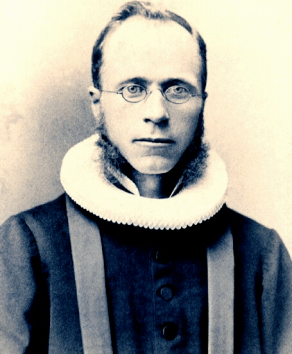 Iver Scheie
Iver Scheie
The Whitewater congregations were small and,
as Sunniva noted, did not even have their own
buildings.
Our people rented the church from them for
some years. Then a man in our congregation
had a store building and the upstairs was
vacant. So that was fixed up and we had our
services there. There were chairs and a little
organ like a field organ. This man's daughter
played the organ. Later she went away and
then I got my start at being an organist. But
later we went back to the church and that is
where I was confirmed.
There were only six or eight families in the congregation. But often there were
students at the Normal School who attended our church and some of them were
good singers and sometimes served as a choir, or quartet mostly.
Father's salary was around $450 or $500 a year. The trustees collected that, but
Father went around and collected for the synodical treasury, and also for
subscriptions to the church paper....
There were offerings for the pastor in all congregations at Christmas, Easter and
Pentecost. And people paid for baptisms, confirmation, funerals and weddings....
We received much food from people: butter (home churned), milk, cream, eggs,
chickens, meat, berries, apples, etc... The farmers probably brought oats, too, and
maybe hay for the horse....
When there was a new baby, the women would bring big dishes of "rommegrot"
and other delicacies.
They had some contact with other members of Iver's family.
Our cousins, the Schye's from Chicago came to visit us sometimes. There were
five boys; three of them came at different times. There were two girls but I never
saw them. Uncle, Father's brother, visited us only once that I remember. His
name was Lodver but was known as Louis in Chicago. Aunt Pauline visited us
once with the oldest son Ole (Oliver). He taught me to play on the organ when he
was there....
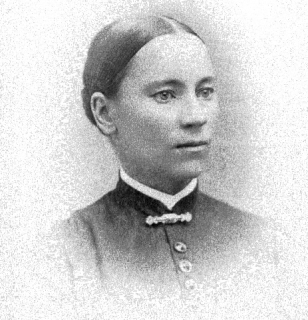 Anne Mason
Anne Mason
The Schye's used to come by bicycle. The
first one I can remember was Charlie and he
had one of those with a big wheel and a little
wheel behind it. Iver visited us the last
summer we were there....
Father's sister Anne (Mrs Christ Mason) lived six miles out of town and we often
went out there....
Anne (or Ane or Ana) had married Christian Mason June 2, 1887, after the
death of her first husband named Ulland. He could have been someone related to
Anette Ulland, Iver's first wife?
Grandma Scheie (Anne, the widow of Ole Lodversen Scheie) had her home at Aunt
Ane's as long as she lived. She had a room by herself, had a little stove and did her
own cooking....Grandma knit hose for Father as long as she lived. In summer she
sat outside on a box or the chopping block and knit. I think she must have spun
the yarn at one time as she had a spinning wheel in her room.
She was very hard of hearing; I could scarcely talk to her at all. (I think she went
to church) with Uncle and Auntie until she became so very deaf. (But even then)
on Sunday she always dressed up: her Sunday dress, a clean white apron and a lace cap.
She always wore a cap or little scarf on her head....She had a book of sermons that
she read and her hymn book that were faithfully used. Father said once that she was
the one who gave him his first theological education....
In the 1900 census, Grandma Anne is reported to have had 8 children, 5 of whom were still living.
From that we know that Anna, Ole and Hans had died. She also said she could read English, but
could not write it or speak it.
Grandma Anne died February 19, 1901 at the age of 93 and is buried at Skoponong Church
cemetery northeast of Whitewater, near Palmyra, Wisconsin. Since Iver was pastor of the church,
he presumably officiated at her funeral. Grandma Anne’s daughter Anne Mason and her family
are also buried there.
A move west
Iver served as pastor in Whitewater for nineteen years. Then in 1902, he came home from a
synod meeting and said he had received a call to go to Flandreau, South Dakota, for one year.
We were quite thrilled, but I don't think Mother was too overjoyed, although she
realized it was becoming more difficult for Father to serve in Whitewater. They were
demanding more English services and some of the young people were being confirmed
in the English language. Father, having grown up in Norway, was not too well at home
in English, so it was an effort for him to preach in English.
For the moving Father arranged for a railroad car, so nearly everything we owned went
with us. He even bought several tons of coal, since he found out he would have to pay
much more for it in South Dakota.
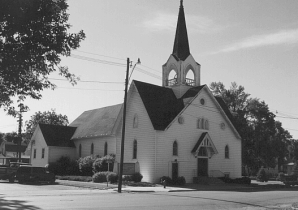 Our Savior's Lutheran Church, Flandreau, SD
Our Savior's Lutheran Church, Flandreau, SDIn 2000
They knew the stay in Flandreau was for just
one year because the minister of the
congregation, Rev. Johan Anton Blilie, was to
be gone only that long conducting surveys for
the synod to determine where new
congregations should be established.
The house the Scheies were to occupy in
Flandreau was not available when they
arrived, so for three weeks moved in with the
Blilies and their three daughters in their new
house. As for kiving with sixteen people in
the house, Sunniva called it"a hard time for
mother."
One of the Blilie daughters, Katharina, later wrote “The Scheie’s were wonderful people, helpful,
quiet, and agreeable, so the work ran smoothly.” I still marvel how we got along under the
primitive conditions, for we had no modern conveniences except water in the kitchen. Today, as I
enjoy the many modern conveniences, I marvel at how Mother and Mrs. Scheie could do the
work.”
After three weeks, the Scheies moved to their own house even though it still wasn't quite ready.
To McIntosh
After what Sunniva called "an enjoyable year"in Flandreau, the family moved in September to
McIntosh, Minnesota, where Iver had been called. There, too, the parsonage was being
renovated and was not ready when they arrived. So they stayed with congregation members until
they could move in.
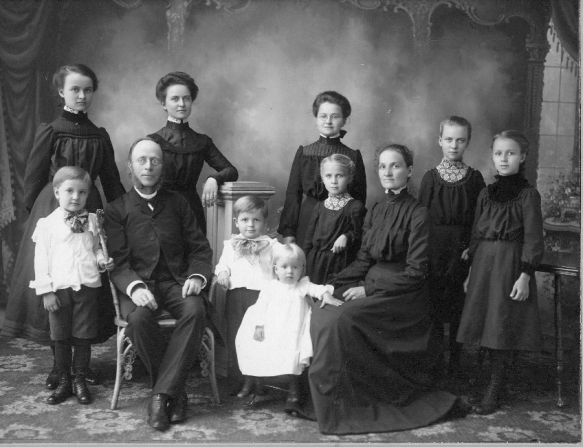 Johanna, Sunniva, Amanda
Johanna, Sunniva, AmandaOlaf, Father Iver, Lodver,Marie, Agnes, Mother Marie, Jennie, Olga
The parish had four congregations: apparently one, St. Luke's, in McIntosh, one in Erskine and
two in the country, one of which was named Sand Hill. They were affiliated with the Norwegian
Synod as were Iver's churches in Whitewater and Flandreau. McIntosh also had a second
Norwegian Lutheran congregation affiliated with the United Norwegian Lutheran Church. The
pastor of that church was Rev. J. B. A. Dale, the father of Mars Dale who became a lifelong
friend of the family, and a college and seminary classmate of Lodver's.
Among the members of the United church about then was the widow Dorthea Oppegaard, her
daughters Dagny and Ellen and step-children Emil, Georgine and Goodwin. They had moved into
McIntosh from their farm near Erskine following the death of their husband and father, John
Oppegaard three years earlier.
Sunniva recalled going with her father to services at his church in Erskine.
I played the organ there for awhile. This was Advent Sunday; I remember his
sermon was about the coming of the King. I heard that sermon two or three times.
He perhaps gave it in McIntosh first and then sometimes I went with him to Sand
Hill and played the organ there. It probably was the second or third Sunday in
Advent, because as I remember it, it was his last service. He didn't feel good and
next day was worse. Dr. Ohnstad was called and he ordered a steam bath for him.
He had pains in his limbs, seemed like rheumatism. He was not right down in bed
very many days, but kept getting worse, and was restless at night so it was hard on
mother....
Before he became delirious he told Mother he was going to die and gave her some
suggestions on getting work for us. He told her when he went to the synod
meeting in June he felt it was the last time he would attend this meeting.
The last night he lived (he had been delirious for a few days) he went through a
complete church service, Mother said. I awoke hearing him sing “Skriv dig Jesu
paa mit hjerte” (On my heart imprint thine image). The next day was Sunday. Dr.
Ohnstad called in a doctor from Fosston for consultation, but there was nothing
that could be done. He passed away that day, December 18 (1904). That was
very hard on Mother, but people were so thoughtful and kind and did much to help
us....
His last words, quoted in a 100th anniversary booklet for Our Savior's Lutheran Church in
McIntosh, were (in Norwegian) “Help one another.”
Iver had told Marie that he liked Rev. Salveson who had recently moved into a nearby parish and
would like him to deliver the sermon at his funeral. And so it was.
The cause of death was believed to be erysipelas which he apparently contracted from his horse.
He had served the McIntosh parish a little more than two years.
Erysipelas is an infection affecting primarily the skin and is caused by
streptococci. It is a generally benign disease, but can be fatal when associated
with bacteremia in very young, elderly or immunocompromised patient. It is now
treated with antibiotics. Mortality is less than 1% in treated cases. (From an
Internet site).
Iver was 56 when he died. He was buried at St. Luke’s Cemetery southeast of McIntosh.
He left a 43 year old widow and nine children ranging from 3 to 20. From all accounts their life
was a financial struggle. Marie earned some income by "boarding" or serving meals to teachers.
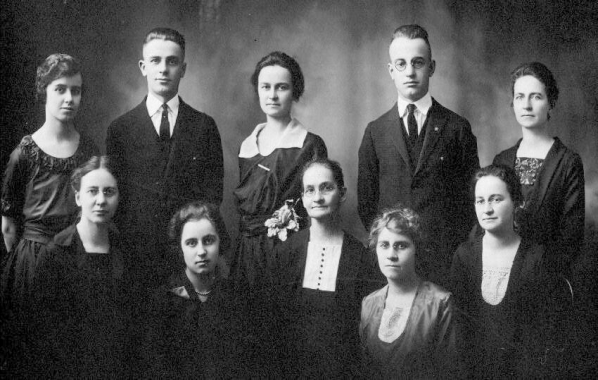 Jennie, Lodver, Johanna, Olaf, Sunniva
Jennie, Lodver, Johanna, Olaf, SunnivaOlga, Marie, Mother Marie, Agnes, Amanda
While it was a financially difficult time, they said the people of McIntosh were very kind.
Education was important to them; as they completed school and started working, each
would help the younger ones pay their college expenses.
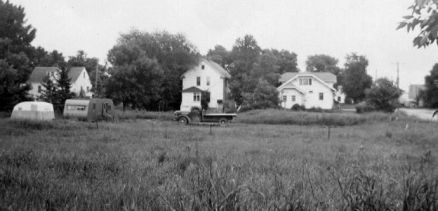 The family’s house in McIntosh (center)
The family’s house in McIntosh (center)
Although her children gradually moved away, Marie remained in McIntosh some twenty years.
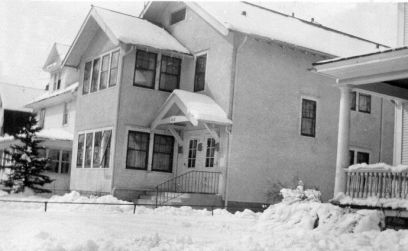 3332 Fifth Avenue South, Minneapolis
3332 Fifth Avenue South, Minneapolis
Some time during the 1920s or 30s, Marie moved to Minneapolis where she lived with Jennie. It
may not have been their first address, but for some years they rented the upper duplex at 3332
Fifth Avenue South.
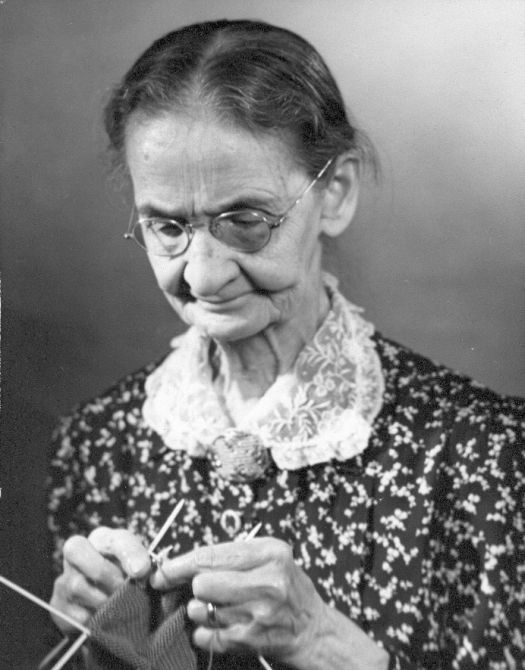
She lived a quiet life there, most of the time in good health, until her death August 24, 1954 at
age 92. She is buried at Crystal Lake Cemetery.